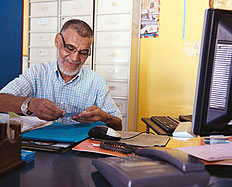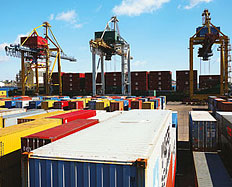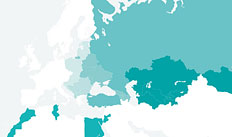COUNTRY ASSESSMENTS
Morocco
HIGHLIGHTS OF THE PAST YEAR
- Following robust economic growth in 2011, economic activities slowed down in 2012. A weak agricultural harvest due to drought along with persistant weaknesses in the eurozone, the major source of external demand for Morocco, continue to dampen growth prospects.
- The widening of both the current account and fiscal deficits pose significant risks to the outlook. In response to the crisis last year, the government raised wages and increased subsidies and spending. The IMF programme agreed in August provides both confidence and a buffer against future shocks.
- Notwithstanding major progress, some crucial reforms are still incomplete. These are needed to enhance competitiveness in major sectors in the economy, as well as to improve the general business environment.
KEY PRIORITIES FOR 2013
- Significant reforms are required in the energy, power, and natural resource sectors. A combination of state-owned monopolies within a single-buyer market and considerable energy subsidies has created substantial market distortions. Subsidy expenditures can be reduced in conjunction with policies to replace open-ended commitments with targeted support for the poor.
- There are urgent reform needs in the infrastructure sector, especially at the municipal level. The challenge is to build municipal capacity to manage, run and efficiently operate large infrastructure projects including transparent participation of the private sector through PPPs.
- The renewable energy sector is growing, and the ambitious green energy plan requires resources and investment. To make use of wind and solar energy to generate power in Morocco, it is necessary to overhaul the transmission systems and introduce a competitive market for electricity.
MACROECONOMIC PERFORMANCE
Although the overall macroeconomic position held up well in 2011, the resilience of the Moroccan economy has weakened in 2012. While real GDP growth reached 5.0 per cent in 2011, the economy slowed considerably to 2.8 per cent year-on-year in the first quarter of 2012, and to 2.3 per cent in the second quarter, on the back of a sharp decline in agricultural production (around 15 per cent of GDP) due to droughts, and moderating domestic demand. Manufacturing and mining activity declined throughout the first six months of the year, and capacity utilisation rates in the third quarter point to continued weakness. In addition, construction (which was a driver of growth in the first quarter) slowed down, dragged down by diminished business confidence and a slow‑down in the real estate sector. FDI, however, increased by 6 per cent year-on-year in H1 2012, reflecting improved prospects of large-scale projects materialising in the short to medium term.
The fiscal and current account deficits have widened over the year, and pressures have persisted in the first half of 2012. This has prompted the Moroccan authorities to seek and receive a US$ 6.2 billion Precautionary and Liquidity Line from the IMF to help cushion the economy against any further external shocks. Morocco’s trade deficit rose in the first quarter of 2012, after reaching 20 per cent of GDP in 2011, but improved slightly in the second quarter, on the back of reduced energy prices per volume. The external current account deficit reached 8 per cent of GDP in 2011, and widened further in H1 2012, on the back of faltering exports and a pickup in imports associated with higher energy prices, but is expected to narrow throughout the year as oil prices moderate. However, continued weakness in the eurozone (Morocco's main trading partner) contributed to lower tourist receipts, exports and remittances. On the other hand, the general government deficit in 2011 rose to 7 per cent of GDP (excluding privatisation receipts), its highest level in 20 years. Much of it reflects subsidies for basic food staples and energy products, which amounted to six per cent of GDP (with fuel subsidies alone amounting to 17 per cent of spending), and wage increases to alleviate political and social unrest.
Several factors pose a risk to a strong economic recovery in Morocco. First, a further deterioration in the eurozone would negatively impact Morocco’s growth prospects substantially, given the close external trade and financial links. External shocks could further widen the current account deficit, while a growing budget balance could reduce the government’s fiscal space. Lastly, the failure so far by the authorities to enhance Morocco’s competitiveness through improvements in human capital and in the business environment poses further downside risks to the medium-term outlook of the country.
MAJOR STRUCTURAL REFORM DEVELOPMENTS
Reforms that have been enacted in Morocco have been largely successful. Substantial progress has been made in the privatisation agenda since the beginning of the last decade, resulting in a boost to competitiveness in a number of sectors, including telecommunications and other service sectors. As a result the privatisation agenda, with the exception of utilities and natural resources, is by now almost complete. These efforts were coupled with structural reforms in the transport, energy and telecommunications sectors. Average import tariffs were substantially reduced even though non-tariff barriers, in particular in the agricultural sector, still remain substantial. However some capital account restrictions on residents remain, including surrender requirements for export proceeds and limits on foreign investments by local institutional investors such as pension funds.
There remains a significant unfinished reform agenda. Reforms are needed to improve the business environment in general, as regulatory capture has had an adverse impact on entry and competition across a number of industrial sectors. Barriers to entry, cross-ownership in some sectors and low levels of corporate governance have contributed to lower levels of competitiveness. In addition, labour market rigidities have contributed to the high unemployment rates in the country.
In response to its deteriorating fiscal position, the government raised the prices of key subsidised items in 2012. In June energy prices were hiked by 16 per cent, while subsidies on soft wheat imports were reduced by 15 per cent in September. The government is considering plans to further reform the subsidy system, including measures such as adjustments of administered prices, conditional cash transfers and targeted programmes.
Reforms are crucially lacking in the energy and infrastructure sectors, and tariff reform is needed across the board to improve cost recovery. Delivery of municipal services faces large reform challenges and is constrained by poor local capacity. After many years of delay, regulatory agencies in some sectors, including energy, insurance and securities, have recently moved to become more independent. Reforms are needed in the energy sector to ensure unbundling of the sector, gradual liberalisation of prices, creation of a competitive wholesale market, independence of regulatory agencies, and improvement in energy efficiency. In this regard, the Ministry of Energy has recently decided to move ahead with the unbundling of the vertically integrated energy utility ONE and corporatising its units, with EU assistance.
Measures have been put in place to exploit Morocco’s potential in the sustainable energy sector. The use and development of renewable energy technologies has been a priority for the government, but has only recently become a major policy objective. Ambitious programmes exist, such as the Green Energy plan, to increase the share of renewables in the country’s total energy demand. Morocco has started to develop the legal and regulatory framework in order to achieve these targets. The government passed four laws dealing with renewables and energy efficiency in early 2010. Under these laws, a renewable energy agency as well as an agency (ANDEREE) to promote solar technology, were established. The laws provide financial incentives and government guarantees for renewable energy producers, including long-term off-take agreements with ONE at pre-determined prices.
Reforms in the financial sector have been successful, but some additional measures are needed to increase the sector’s robustness. Regulatory frameworks are reasonably advanced in both the banking and non-banking sectors, with further improvements in the pipeline, including independence of regulatory agencies for the insurance and securities markets. While the money and government bond markets are well developed, securities markets are small and lack liquidity and the regulatory and tax frameworks for more advanced products (such as securitisations and derivatives) are yet to be developed.







